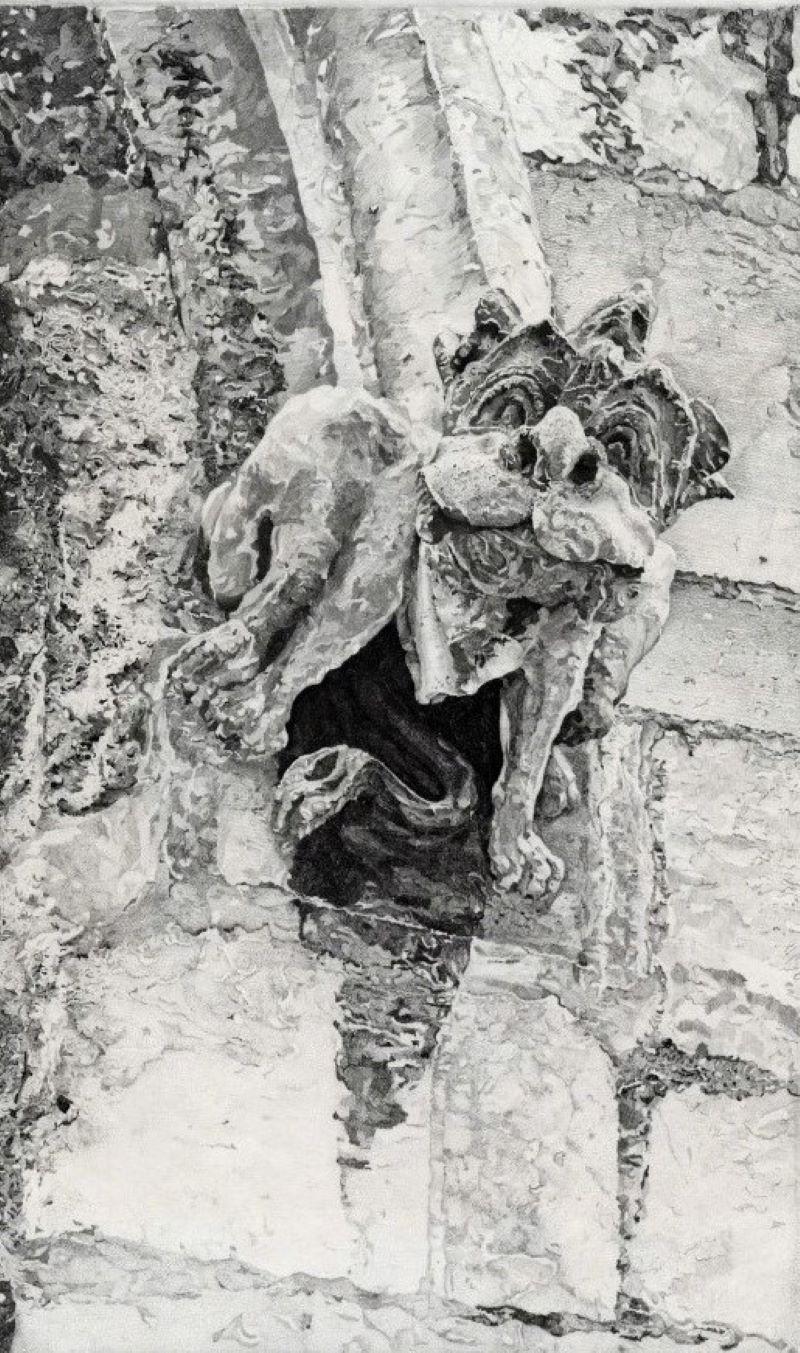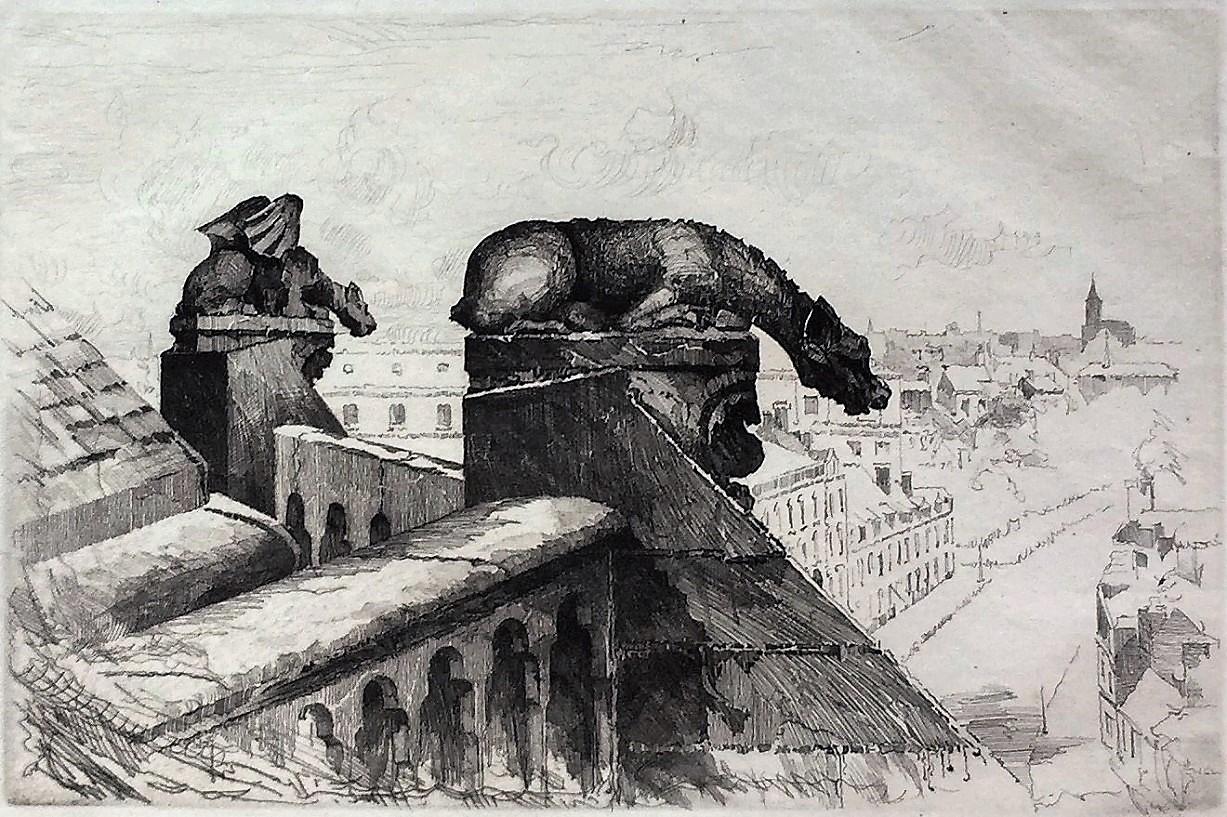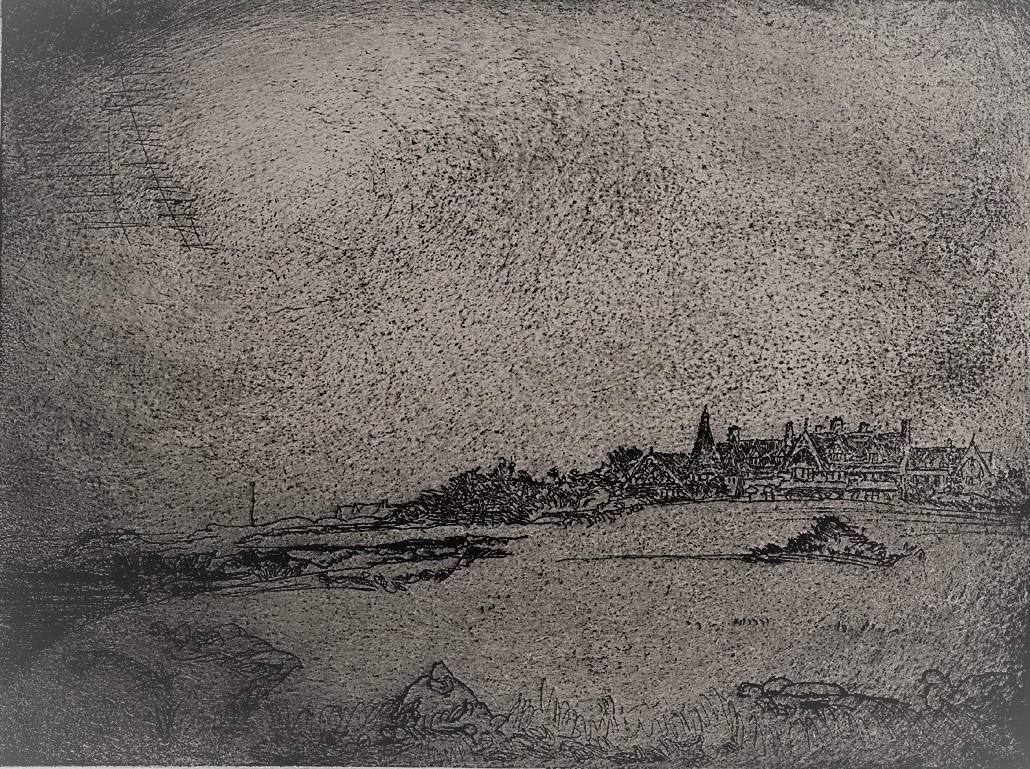Items Similar to The Anchor
Want more images or videos?
Request additional images or videos from the seller
1 of 7
Arthur John Trevor BriscoeThe Anchor1926
1926
About the Item
The Anchor. 1930. Etching. Hurst catalog 268 state ii. 7 x 6 3/4 (sheet 10 3/4 x 7 5/8). Edition 275. A rich impression with plate tone printed on antique 'GR' laid paper with a hunting horn countermark. As published in J. Lauer's volume, A complete catalogue of the Etchings and Drypoints of Arthur Briscoe. One spot in the right-hand sheet; otherwise in excellent condition. Signed in ink Housed in a 16 x 20-inch archival mat, suitable for framing.
The Roaring Forties is the name given to strong westerly winds found in the Southern Hemisphere, generally in the areas between the latitudes of 40 and 50 degrees south in the Southern Hemisphere, where the prevailing winds blow persistently from the west. The roaring forties have strong, often gale-force, winds throughout the year. They were named by the sailors who first entered these latitudes. Norman Wilkinson also etched the subject.
In 1899 he acquired a studio in Malden, Essex, and bought a 3 ton cutter which, with his young family, he would spend eight or nine months a year, sailing to Calais, along the Belgian coast and through the Dutch waterways, constantly sketching and painting in both oil and watercolor.
In 1922, after a meeting with the etcher James McBey, Briscoe returned to etching once more producing plates of some of his sea sketches. The two artists sailed together in Briscoe's, forty-ton yacht, the "Golden Vanity." Briscoe produced 189 etchings dealing with the sea and the sailing ship. His works were eagerly sought after and purchased by collectors throughout the 1920s and 1930s. His work was always technically accurate and very evocative of the last years of square-rigged sailing ships. Briscoe left an invaluable historical record of the workings of the last great commercial vessels.
- Creator:Arthur John Trevor Briscoe (1873 - 1943, British)
- Creation Year:1926
- Dimensions:Height: 20 in (50.8 cm)Width: 16 in (40.64 cm)Depth: 2 in (5.08 cm)
- Medium:
- Movement & Style:
- Period:
- Condition:
- Gallery Location:Storrs, CT
- Reference Number:1stDibs: LU33523412431
About the Seller
5.0
Recognized Seller
These prestigious sellers are industry leaders and represent the highest echelon for item quality and design.
Platinum Seller
These expertly vetted sellers are 1stDibs' most experienced sellers and are rated highest by our customers.
Established in 1977
1stDibs seller since 2016
Typical response time: 1 hour
Associations
International Fine Print Dealers Association
- ShippingRetrieving quote...Ships From: Storrs, CT
- Return PolicyA return for this item may be initiated within 3 days of delivery.
More From This SellerView All
- The Gothic SpiritBy John Taylor ArmsLocated in Storrs, CTThe Gothic Spirit (also called A Gargoyle, A Gothic Spirit). 1922. Etching and stipple. Fletcher 120. 11 5/8 x 7 (sheet 15 1/4 x 11 1/4). Gargoyle Series #8. Edition 130. Illustrated...Category
1920s American Modern Landscape Prints
MaterialsDrypoint, Etching
- Guardians of the Spire (Amiens Cathedral Number 2)By John Taylor ArmsLocated in Storrs, CTGuardians of the Spire (Amiens Cathedral Number 2). 1921. Etching. Fletcher 102. 6 3/4 x 9 7/8 (sheet 8 7/8 x 13 3/4). Gargoyle Series #4. Edition 75. Illustrated: Dorothy Noyes Arms...Category
1920s American Modern Landscape Prints
MaterialsDrypoint, Etching
- House on Cliff Walk, Newport, Rhode IslandBy Clifford Isaac AddamsLocated in Storrs, CTHouse on Cliff Walk, Newport, R.I. 1931-1932. Etching and drypoint. Hausberg catalog 13 state .i/ii. Edition 75 in this state. 5 7/8 x 7 7/8 (sheet 9 x 13 1/2). A rich impression pr...Category
Mid-20th Century American Modern Landscape Prints
MaterialsDrypoint, Etching
- Old Brownstones -- New YorkBy Lawrence WilburLocated in Storrs, CTOld Brownstones-- New York. c. 1985. Etching and drypoint. 8 7/ 8 x 12 1/3 (sheet 16 5/8 x 16 1/4). Fourth state. Printed on cream wove paper, on the full sheet with deckle edges. A rich impression in pristine condition, housed in an archival folder. This etching has never been matted. Provenance: the artist's estate. Signed, titled, and annotated 'Fourth state -- wheel changed to left' and 'Steves' in pencil. A dramatic view of a Manhattan neighborhood. Painter and printmaker Lawrence Nelson Wilbur...Category
20th Century American Modern Figurative Prints
MaterialsDrypoint, Etching
- Manhattan MountainsBy Lawrence WilburLocated in Storrs, CTManhattan Mountains. 1938. Etching and drypoint. 14 3/4 x 12 3/8 (sheet 17 1/4 x 14 3/4). Artist proof, previous to the edition of 40. An atmospheric impression printed on buff-colored laid paper. Signed and dated in the plate. Signed, titled, and annotated 'Final state' and 'Jones Proof'in pencil. Housed in an archival sleeve. Painter and printmaker Lawrence Nelson...Category
20th Century American Modern Figurative Prints
MaterialsDrypoint, Etching
- The Spire -- New YorkBy Lawrence WilburLocated in Storrs, CTThe Spire -- New York. 1985. Etching and drypoint. 14 1/2 x 11 (sheet 22 1/2 x 18). Trial proof of the second third, prior to the edition of 100. Printed on Rives cream wove paper, on the full sheet with deckle edges. A rich impression in pristine condition, housed in an archival sleeve. This etching has never been matted. Provenance: the artist's estate. Titled, annotated 'third state - trial proof' and signed in pencil. A dramatic view of the Chrysler Building. Painter and printmaker Lawrence Nelson...Category
20th Century American Modern Figurative Prints
MaterialsDrypoint, Etching
You May Also Like
- Irving Guyer, Christmas Trees on Second Street (NYC)By Irving GuyerLocated in New York, NYPhiladelphia-born Irving Guyer attended the Art Students League and worked in New York City before moving to California. This print is signed and titled i...Category
1930s American Modern Figurative Prints
MaterialsDrypoint, Etching
- The Old Smyth Gate, Charleston, South CarolinaBy Alfred HuttyLocated in Middletown, NYA view of the gateway to Simmons-Edwards House (14 Legare Street), also known as the Pineapple Gate House. Etching with drypoint on watermarked "Hand Made" laid paper, signed in pen...Category
Early 20th Century American Modern Landscape Prints
MaterialsLaid Paper, Drypoint, Etching, Handmade Paper
- Guardians of the Spire; Amiens Cathedral Number 2By John Taylor ArmsLocated in Middletown, NYGuardians of the Spire; Amiens Cathedral Number 2 New York: 1937. Etching and drypoint on watermarked F.J. Head cream-colored, antique laid paper, 6 3/4 ...Category
Mid-20th Century American Modern Figurative Prints
MaterialsDrypoint, Etching
- Tugs on the HudsonBy Charles Frederick William MielatzLocated in Middletown, NYDrypoint etching with engraving printed in black ink on Japanese mulberry paper, 4 1/2 x 3 3/8 inches (113 x 84 mm), full margins. In superb condition. A beautiful New York City rive...Category
Early 20th Century American Modern Landscape Prints
MaterialsHandmade Paper, Drypoint, Etching
- The Acropolis, AthensBy Louis Conrad RosenbergLocated in Middletown, NYEtching and drypoint on cream wove paper, full margins. Signed in pencil, lower right margin. In generally good conditon with several scattered very light spots of foxing throughout,...Category
1920s Modern Landscape Prints
MaterialsHandmade Paper, Drypoint, Etching
- Palazzo dell'AngeloBy John Taylor ArmsLocated in Middletown, NYPalazzo dell'Angelo 1931 Etching and drypoint on cream-colored, handmade laid paper with deckle edges, 7 1/4 x 6 3/4 inches (185 x 171 mm), edition of 100, full margins. Signed, dated and numbered "Ed. 100" in pencil, lower margin, second state (of three). Printed by Henry Carling, New York. Extremely minor mat tone and some inky residue in the top right corner, all unobtrusive and well outside of image area. An exquisite impression of this intricate image, with astonishing detail, and all the fine lines printing clearly. The image represents the first print which Arms printed on his own handmade paper. Framed handsomely with archival materials and museum grade glass in a wood gilt frame with a flower and garland motif. Illustrated: Dorothy Noyes Arms, Hill Towns and Cities of Northern Italy, p. 180; Anderson, American Etchers Abroad 1880-1930; Eric Denker, Reflections & Undercurrents: Ernest Roth and Printmaking in Venice, 1900-1940, p. 116. [Fletcher 233] Born in 1887 in Washington DC, John Taylor Arms studied at Princeton University, and ultimately earned a degree in architecture at the Massachusetts Institute of Technology in 1912. With the outbreak of W.W.I, Arms served as an officer in the United States Navy, and it was during this time that he turned his focus to printmaking, having published his first etching in 1919. His first subjects were the Brooklyn Bridge, near the Navy Yard, and it was during his wartime travel that Arms created a series of extraordinarily detailed etchings based on Gothic cathedrals and churches he visited in France and Italy. He used what was available to him, namely sewing needles and a magnifying glass, to create the incredibly rich and fine detail that his etchings are known for. Upon his return to New York after the war, Arms enjoyed a successful career as a graphic artist, created a series of etchings of American cities, and published Handbook of Print Making and Print Makers (Macmillan, 1934). He served as President of the Society of American Graphic Artists, and in 1933, was made a full member of the National Academy of Design. In its most modern incarnation, Palazzo dell'Angelo was constructed in or around 1570. The building, which has a rich and storied history, was erected upon the ruins of an earlier structure which predates the Gothic period. Some remnants of the earliest features of the residence were most certainly still visible when Arms visited, as they are today. Having a background in architecture, there's no question that Arms was moved by the beauty, history and ingenuity represented in the physical structure. One thing specifically gives away Arms's passion for the architecture, and that is the fact that he focused on the building's Moorish entranceway, balustrade, and two mullioned windows, and not on the curious Gothic era bas-relief of an angel nestled into the facade of the building, after which the structure is named. The sculpture itself doesn't appear in Arms's composition at all, despite the fact that it is the feature of the building that is most famous in its folklore. Arms instead focuses on the oldest portion of the architecture, even documenting some of the remnants of a fresco, and a funerary stele for the freedman Tito Mestrio Logismo, and his wife Mestria Sperata (visible above the water level, to the left of the door, behind the gondola), which was first described in 1436. Among the many notable bits of history regarding the Palazzo, it has been documented that Tintoretto painted frescos of battle scenes on the facade of the building. The paintings have been lost to time and the elements, but not entirely to history. The empty frame...Category
1930s American Modern Figurative Prints
MaterialsDrypoint, Etching
Recently Viewed
View AllMore Ways To Browse
Oil Paintings Of Sailing Ships
Sailing Vessels Paintings
Hunting Etchings
Oil Rig
Golden Horn
Dutch Sail
1930s Drypoint
Antique Paintings 1922
Southern Antique Oil Paintings
Hemisphere Antiques
Antique Sailing Painting
3 Sail Ship
Dutch Sailing Painting
Sailing Yachts Paintings
1920s Yacht
Modern Rigs
Antique Sail Painting
Dutch Sailing Ship





